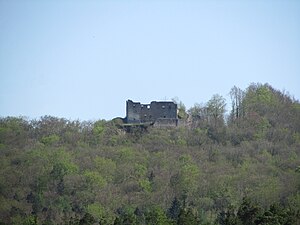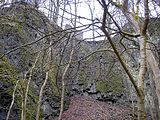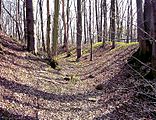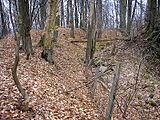Bramberg Castle (Haßberge)
| Bramberg Castle | ||
|---|---|---|
|
Bramberg Castle on the mountain of the same name |
||
| Creation time : | probably during the 11th century | |
| Castle type : | Höhenburg, summit location | |
| Conservation status: | Restored ruin | |
| Standing position : | Ministeriale | |
| Place: | Burgpreppach -Hohnhausen- "Bramberg" | |
| Geographical location | 50 ° 6 '29 " N , 10 ° 38' 4" E | |
| Height: | 494.3 m above sea level NN | |
|
|
||
The Bramberg Castle is a ruined castle of a Würzburg district castle in the Haßberge in the Lower Franconian district of Haßberge in Bavaria (Germany). The former aristocratic and official residence was renovated in 1974/79 and is freely accessible.
Geographical location
The ruins of the Bramberg summit castle are located within the Haßberge Nature Park on the summit of the 494.3 meter high Bramberges, an extinct volcanic cone of the Heldburg gang , around 2 kilometers northwest of the village of Bramberg , which is a western district of Ebern , and around 5 kilometers ( each as the crow flies ) northeast of the city of Königsberg in Bavaria . It is surrounded by the Goßmannsdorfer Forest.
history
founding
The Bramburg was probably built as early as the 11th century to protect the high road running over the Haßbergkamm or as a bulwark against the Main-Rednitz-Wends located in this area. The Germanization and conversion of this pagan population group was probably largely completed shortly after the establishment of the Bamberg diocese .
The first documented mention of the Bramburg is dated to 1108, when the Lords of Bramberg were enfeoffed with the rule.
Grinding 1168
In 1168, the predecessor of the current castle was destroyed by imperial orders because of alleged robber baronism . Friedrich Barbarossa decreed in a document issued on July 11th of this year at the Würzburg Reichstag that the castle was to be razed : ... quia de castro Bramberc quies pacis totius provinciae saepe turbabatur ... (for example: ... since from Bramberg Castle from Fried and peace of the whole area was disturbed ...).
The Lords of Bramberg, who sat on the mountain as Bamberg servants, are said to have built a new fortress on the Haubeberg near Ebern ( Rauheneck Castle ). The Brambergs were probably originally of noble origin, but appeared as followers of the Bamberg Monastery as early as the 12th century . Bramberg Castle was certainly once an imperial fiefdom or owned by the family, which apparently had only signed a service contract with the diocese, but submitted to the sovereignty of the bishops in the early 12th century.
The real reason for the demolition of the castle is likely to be found in the power struggles between the two rival monasteries, Würzburg and Bamberg . The bishops of Würzburg in particular tried with all means throughout the Middle Ages to seize the castles and lands of their spiritual brothers. If it was the allegation of robber barracking, an alleged counterfeiter on the rock castle was used as a pretext for the destruction of the Rotenhan castle in Bamberg .
renovation
The Bramberg should never have a castle again. Nevertheless, with the permission of the emperor , the Würzburg prince-bishop had a new fortification built on the castle hill from 1250 and made this the center of the office of the same name . The core castle in the southeast was rebuilt around 1330/40 with access through a gate tower from the 16th century. The Randhausburg with a ring and neck ditch dates back to the 12th century. The outer gate in the southwest was in 15./16. Built in the 16th century, the younger wing in the northwest in the 16th century.
Peasants' War and Decline
In 1525 the Bramburg was damaged by the insurgents during the German Peasants' War and left to decay after it was abandoned in 1560.
Backup in the 20th century
By the middle of the 20th century, the basalt of the volcanic vent was quarried in two quarries, which would have destroyed almost the entire castle complex. The two companies were established between 1920 and 1930. As a result of the First World War , the population of the two surrounding villages of Bramberg and Hohnhausen was severely impoverished. The opening of the basalt quarries was intended to offer fathers of families an opportunity to earn a living. As early as 1934, however, the government commissioner for nature conservation tried to stop the dismantling because the ruins would be endangered. In 1937 the site was finally placed under protection.
In 1947, the lack of urgently needed basalt deliveries from the Thuringian Rhön forced the quarries to be reopened, which were now increasingly exploited. Around 1952, the nature and monument protection authorities and associations started a violent dispute with the quarry operators. This conflict, dubbed the “Bramberg War” by the local press, ultimately led to the second quarry being closed in 1955 and the dismantling of the gravel works and other operating facilities.
After the quarry was finally closed , the ruins were secured by the Ebern Forestry Office between 1974 and 1979.
description
A spacious parking lot with a walking board was created below the castle ruins, from which you can climb to the castle in 15 minutes.
Through beautiful mixed forest stands you pass the two quarries that were closed in 1955 and reach the ruinous gate of the outer bailey . On the left behind the gate are the remains of the former farm buildings, on the right the ruins of the main building rise. The rear part of the castle complex fell victim to the basalt mining , which was ended just in time before the castle was completely lost.
The protruding gate tower with its slightly raised entrance now leads to the two-story residential building. The ogival inner gate was secured by a portcullis , the claw stones of which can still be seen. The original wall consists of regular sandstone blocks with pincer holes, the tower portal has been modernized.
At the south end, the stump of a stair tower is still preserved, under which the entrance to a largely buried cellar is located. Just a few decades ago, you could walk through this basement to the rear room on the ground floor. During the somewhat rustic securing of the castle in the 1970s, this passage was walled up beyond recognition.
The partly double ring trenches around the complex, which are probably from the previous castle, are impressive . The ruins, on the other hand, are mainly from the late Gothic period . However, the course of the trench is interrupted in the northeast by the basalt quarry, which was driven up to the main building on this side (danger of falling). A remnant of the curtain wall in the east of the inner castle is documented on the plan in the inventory tape from 1912 . At that time the trench in front was still intact.
In 2008, some old trees were removed from the courtyard in a controversial operation. The ruins should also be cleared in the outer area.
The castle is a stop on the castle history trail of the Haßberge district.
documentation
The condition of the castle ruins in 2006. Due to the improper renovation in the 1970s, important structural details were obscured, but the existing structure was secured for a long time.
literature
- The art monuments of the Kingdom of Bavaria, III, 5, District Office Hofheim , Munich 1912, pp. 31–34.
- Franz Kirchner: The Bramberg ruins . In: 1985 annual gift from the Ebern Citizens' Association for its friends and members . Ebern, 1985.
- Ursula Pfistermeister: Well-defended Franconia - Volume 3: Castles, fortified churches, city walls around Bamberg, Bayreuth and Coburg . Fachverlag Hans Carl GmbH, Nuremberg 2002, ISBN 3-418-00387-7 , p. 31.
- Joachim Zeune : Castles in the Eberner Land . Ebern 2003, (Eberner Heimatblätter, 2 issues).
Web links
- Bramberg castle ruins with floor plan on Burgenwelt.de
- Reconstruction drawing by Wolfgang Braun
- Overview of Bramberg Castle on panorama-photo.net
















